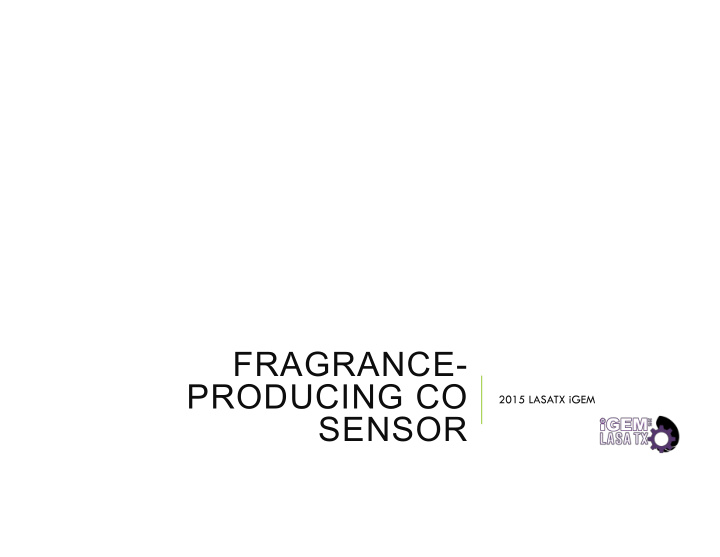



FRAGRANCE- PRODUCING CO 2015 LASATX iGEM SENSOR
RATIONALE AND HUMAN PRACTICES/DESIGN • Disabled Our project: • Fragrance • Natural disasters • Power outages • Energy-independent • Reliance on gasoline generators • Transportable • Accumulation of CO • Cost-effective
EXPERIMENTATION CO pathway (2010 METU Turkey) + Wintergreen pathway (2006 MIT) =
CO pathway Part Description CooA CO transcription activator T7 CooA T7 T7 promoter pCooF Promoter activated by CO-CooA Wintergreen pathway pchBA pchA: isochorismate synthase CooA pchB: isochorismate pyruvate-lyase pCooF BSMT binding site BSMT SAM benzoic acid/salicylic acid carboxyl methyltransferase I Chorismate Endogenous molecule PchA and PchB Methyl Wintergreen smell molecule salicylate
CHEMICAL PATHWAY Chorismate � Isochorismate � Salicylic Acid � Methyl Salicylate
DESCRIPTION CO pathway � CooA transcription activator � T7 promoter Wintergreen pathway � pchBA and BSMT genes � pCooF promoter
CONSTR UCTS E. coli OneShot TOP10 Vectors: pCR2.1-TOPO-TA, pCDFDuet-1 T7-GFP (pCDF) pCooF-GFP (pCDF) T7-CooA (pCR 2.1)
CO EXPERIMENT
EXPERIMENTAL CONSTRUCTS BL21(DE3) Experiment � T7-CooA, pCooF-GFP Controls � Negative: DE3 cells only � Negative: pCooF-GFP � Positive: T7-GFP
CORM-2 • Carbon monoxide releasing molecules • CO in solution • Safety • Various concentrations
PRELIMINARY METHODOLOGY 1) Anaerobic chamber 2) Cultures to 0.6 OD600 w/ glucose 3) IPTG induction 4) Add CORM-2 (100 µ M) 5) Grow anaerobically 6) Fluorescence Intensity
Fluorescence vs. CO presence 72000 70000 68000 Fluorescence 66000 64000 62000 60000 58000 56000 no CORM CORM Series1 69675.53181 61376.63119
MODIFICATIONS • Induced for 20 hours • Springs to increase aeration • Aerobic incubation • Grow to 0.6 OD600 in flasks • 15mL conicals • Inducing at 37 ° C • Multiple CORM concentrations • Triplicates • Resuspending in PBS
Fluorescence vs. CORM concentration in LB/PBS 180000 160000 140000 120000 Fluorescence 100000 LB PBS 80000 60000 40000 20000 0 0 100 200 300 CORM concentration (uM)
FINAL METHODOLOGY 1) Anaerobic chamber 2) Cultures to 0.6 OD600 with glucose 3) IPTG induction 4) Add CORM-2 5) Grow anaerobically 6) Aerobically 7) Resuspended PBS 8) Fluorescence Intensity
DATA Normalized Fluorescence v. CORM concentration under IPTG induction 70000 60000 50000 Fluorescence 40000 30000 20000 10000 0 0 50 100 200 500 CO-RM (uM) DE3 pCoof-GFP T7-CooA pCoof-GFP T7
DATA WITHOUT T7-GFP Normalized Fluorescence v. CORM concentration under IPTG induction, no positive control 700 600 500 Fluorescence 400 300 200 100 0 0 50 100 200 500 CORM (uM) DE3 pCoof-GFP T7-CooA pCoof-GFP
DISCUSSION Time constraint – CO construct tested only Possible errors � CORM � Anaerobic chamber � DO content � Mutation between transforming plasmids Obstacles � Sequence verification � Creating anaerobic environment � Designing primers
FUTURE PLANS • Biosensor • Anaerobic media • Detecting other gases • Other smells
SAFETY • Lab training • Chemicals � CORM-2 � DMSO � EtBr • Fume hood during experimentation
EDUCATION & PUBLIC ENGAGEMENT KXAN KUT
EDUCATION & PUBLIC ENGAGEMENT Synthetic Biology Club 2015 SXSW Create
ACKNOWLEDGEMENTS � Dr. Ellington and all the members of the Ellington Lab � Dr. Mishler and the UT iGEM team � Dr. Davies � Chris Cervini � Joseph Oleniczak
SPONSORS
Recommend
More recommend